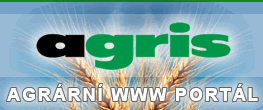INFLUENCE OF SULPHUR FERTILIZATION ON YIELD AND QUALITY OF OILSEED RAPE
09.12.1999 | Odborné konference
H. Zukalová1, J. Matula2, J. Vašák1
1 Czech University of Agriculture, Department of Plant Production,
Praque 6 - Suchdol, Czech Republic
2 Research Institute of Crop Production, Drnovsá 507,
Prague 6, Czech Republic
Abstract
The influence of fertilization by S on the growth was tested by two extreme rates of S (0 and 160 kg S/ha). The growth till the start of flowering is in an agreement for both variants. The influence of S is manifested in the next phaze of development upon the growth acceleration.
The influence of S to the yield, MTS and oil content verifies a closed matabolic chain between accepted N (NO3-1) and S ( SO4-2), when the optimal ratio N/S is 2,4, in the rate 80kgS/ha and 190 kg N/ha. The next doses of S are not effective.
The contents of glucosinolates are increased by higher rates of S, but the increase is not expressive. The high content of glucosinolates in the variant without outside rate of S and N refered to metabolic chain between N and S, which was destabilised by these extremes. It caused a higher production of glucosinolates, which create a defensive system for extreme conditions.
Oilseed rape, sulphur fertilization, quality, yield, MTS, oil content, glucosinolate content.
Souhrn
Vliv hnojení sírou na růst byl sledován při dvou extrémních dávkách síry (0 a 160 kg S/ ha). Růst až do počátku kvetení probíhá shodně pro obě varianty, až v dalších fázích vývoje je zřejmý vliv síry na zrychlení růstu.
Vliv síry na výnos, HTS a olejnatost potvrzují uzavřený metabolický řetězec mezi přijatým N ve formě NO3-1 a S ve formě SO4-2, kdy optimální poměr N/S je 2,4 tj. při dávce 80 kgS/ha a 190kgN/ha. Zdá se, že další dávky síry jsou neefektivní.
Obsahy glukosinolátů se vzrůstajícími dávkami síry vzrůstají, ale nárůst není výrazný. Vysoký obsah glukosinolátů u varianty bez externí dávky síry a dusíku ukazuje na metabolický řetězec mezi N a S, který je těmito extrémy narušen, dochází ke zvýšené tvorbě glukosinolátů, které tvoří obranný systém v případě mimořádných podmínek.
řepka olejná, hnojení sírou, kvalita, výnos, HTS, obsah oleje, obsah glukosinolátů
Introduction
The plants take up nitrogen (N) and sulphur (S) in proportional amounts incorporated into proteins (FRIEDRICH and SHRADER, 1978). The excess or the deficiency of one or both of these elements disturb protein synthesis. Observed interaction between N ( in the form NO3-1) and S ( in the form SO4-2 ) is closely linked metabolically and it can not be resolved individually (FISMES et al., 1999).
Brassica sp. are characterized by a high demand for sulphur. One of the constantly unsolved explanation of the high sulphur demand is explained by the necessity for creation the S-aminoacids and for biosynthesis of glucosinolate. These are the reserves of S, which is used in the case of its default (SCHNUG and HANELAUS, 1993).Anyway literature shows a default of these hypothesis, because glucosinolates are the minor reserve of S in vegetative tissue of “0” and also “00” rape varieties. Glucosinolates represent only < of total S in the rape leaves and stems (GRIFFITHS et al.,1994), their presentation as a reserve of S is unjustified. Their function is rather defensive against harmful elements, it is showed in wellknown complicated indolylmetabolism ( HELMLINGER et al. ,1983). Many of the studies show the role of indolylglucosinolates in rapeseed in relation to diseases and are in harmony with the hypothese by Kutáček (KUTÁČEK et al. 1968) that indolylglucosinolates which are easily transported but limited in segregation are the compound which can release an auxin in the case of extraordinary external factors (frost, diseases) which can affect the plant.
This work is only one part of a large project, which should answer the meaning of sulphur for rapeseed. In this part production of vegetative organs of rapeseed was tested in two extreme levels of S and influence of the different rates of S on the yield of rape and its quality.
Material and methods
The experiment was founded at the experimental establishment Červený Újezd in 7 variants, that were fertilized by increased rates of S (SA, 40, 80, 120, 160 kgS/ha), with the rate of N (LAV, 190kg N/ha). The control variant was without S and with standard rate of N (155kgN/ha). The other two variants without S and with 190 kgN/ha and the variant without S and N should as an extreme underline a closed metabolical link S versus N.
Oil content
The oil content was determinated by nuclear magnetic resonance (NMR).
Glucosinolate content .
Intacts glucosinolates were determined as silylderivates of these glucosinolates by means of gas - chromatography.
Results and discussion.

Sulphur is accepted in sulphate form by roots and is transported to leaves where is transformed to an organic form. In the extreme rates ( 0 and 160 kg S /ha) the course of dry substance biomass is coincident till start the of flowering and expressive difference is evident during the transport of S from leaves to reserve organs. Transport of S needs a sulphate form, and therefore the original form of S in the leaves is transformed to sulphate, which is transformed in reserved organs again to organic one and in this form is preserved. Higher rate of S produces more biomass ( Fig.1.),but it is not adequate to the addition rate of S.

Our results (Fig.2) verify the closed metabolic chain between accepted N (NO3-1) and S (SO4-2), it verifies the hypothesis by FISMES et al.. There is an optimal ratio N/S to yield, MTS and the oil content is 2,4 (rate : 80kgS/ha and 190kgN/ha ).

The yield versus control was extremly increased, but MTS and oil content were equal. It showed, that the next rates of S were noneffective. It is verified by a variant without S and N and by the lowest yield with the lowest protein content. The default of both elements disturbed the biosynthesis of proteins. It is verifies the testing made by FRIEDRICH et al.. The negative corelation between protein and oil content was proved.
The glucosinolate contents (Fig.3), are growing up with increasing rates of S, but the increase of glucosinolate is nonexpressive in comparison with control and does not correspond to the progressive increasing of additive S. Next analyses of S and glucosinolate contents in the siliquaes get a principal place in glucosinolate-biosynthesis. The highest glucosinolate content in the variant without outside rate of S and N, showed an undiscutable closed matabolic chain between N and S. The lack of both of them impaires the synthesis of proteins. The synthesis goes to an increase of glucosinolate production, which makes a defensive system for extreme conditions (KUTÁČEK et al.), such as the default of S and N .
REFERENCES
Fismes, J.,Vong, P.C. and Gucert, A.,1999: Use of labeled sulphur - 35 for tracing sulphur
transfers in developing pods of field - grown oilseed rape.Commun.Soil Sci. Plant Anal., 30( 1&2), 221 - 234.
Friedrich, J.W. and Shrader, L.E:, 1978: Sulfur deprivation and nitrogen metabolism in maize
seedlings.Plant Physiol. 61:900 - 903.
Griffiths, D. W., MacFarlane - Smith, W. H. and Boag, B.,1994: The effect of cultivar, sample date and grazing on the concentration of S - methylcysteine sulphoxide in oilseed and forage rapes (Brassica napus ). Journal of the Science of Food and Agriculture : 283 - 288
Helmlinger, J. Rausch,T. and Hilgenberg,W., 1983: Localization of newly Synthetized Indole-
3 - methylglucosinolate (glucobrassicin ) in vacuoles from horseradish (Armoracia rusticana ). Physiol. Plant, 58, s.302 -310.
Kutáček, M. and Kefeli, V.T.,1968: The present knowledge of indole compounds in plants of
Brassicaceae family.In: Biochemistry and Physiology of Plant Growth Substances ( F. Wightman and G. Sutterfield eds. Ottawa Range Press, 127 - 152.
Schnug, E. and Haneklaus, S., 1993: Physiological background of different sulphur utilisation in Brassica napus varieties.Aspects of Applied Biology 34, 235 - 242.
Acnowledgements
The autors gratefully acknowledge the support from the Grant Agency of Czech Republic. This work was supported in part from research grant No. 521/99/047 and MSM 412100002.
Kontaktní adresa: Ing. Helena Zukalová, CSc.; ČZU Praha, katedra rostlinné výroby; 165 21 Praha 6 - Suchdol; E-mail: ZUKALOVA@AF.CZU.CZ
Další články v kategorii Zemědělství
- Erozní vyhláška má řešit i vítr, Motoristé plánují změny (15.12.2025)
- Šebestyán vedl zemědělský dotační fond, od letoška zastupoval velké agropodniky (15.12.2025)
- Na Litoměřicku a Nymbursku se potvrdila v malochovech newcastleská choroba (15.12.2025)
- Ministr Výborný na poslední Radě ministrů v roce 2025: Podpora inovací je pro budoucnost zemědělství zásadní (12.12.2025)
- Týden v zemědělství podle Petra Havla – č. 50 (12.12.2025)
- MŽP poskytne 300 milionů korun na instalace fotovoltaik na zemědělské půdě (12.12.2025)
- Regenerativní zemědělství se po letech pokusů i praxe jeví jako možné a vhodné (11.12.2025)
- Ministerstvo zemědělství vyhlásilo výsledky veřejné soutěže programu na podporu aplikovaného výzkumu ZEMĚ II (11.12.2025)
- Zemědělci by mohli nově řešit i větrnou erozi, MŽP připravilo novelu vyhlášky (10.12.2025)
- Podcast | Šebek: Nelžeme si do kapsy, že nová vláda bude podporovat malé a lokální farmy (10.12.2025)

 Tweet
Tweet





